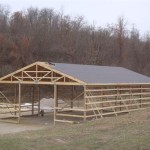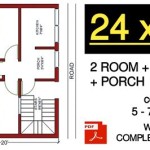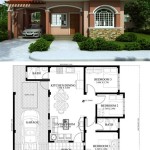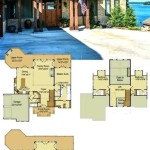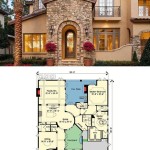Home Floor Plans With In-Law Suite: A Comprehensive Guide
The need for multi-generational living arrangements is becoming increasingly prevalent. Contributing factors include rising housing costs, the desire to care for aging parents, and adult children returning home post-graduation. In response to this demand, home floor plans with in-law suites, also known as accessory dwelling units (ADUs) or granny flats, have surged in popularity. These designs offer a degree of independence and privacy for both the homeowners and their extended family members while fostering a sense of community and shared responsibility within a single property.
A home floor plan incorporating an in-law suite can take various forms, each tailored to specific needs and preferences. The most common types involve a self-contained living space – typically a bedroom, bathroom, living area, and kitchenette – either attached to the main house or designed as a detached structure on the same property. Understanding the nuances of these floor plans is crucial for homeowners seeking to create comfortable, functional, and legally compliant living spaces for their loved ones.
Key Considerations When Planning an In-Law Suite
Before embarking on the design or remodeling process to incorporate an in-law suite, several critical aspects must be carefully considered. These factors directly impact the suitability and long-term viability of the project, ensuring it aligns with both the practical needs of the residents and the legal requirements of the locality.
One vital aspect is zoning regulations and building codes. Local ordinances often dictate the permissibility of ADUs, specifying size limitations, setback requirements, parking standards, and occupancy restrictions. Thorough research and consultation with local planning authorities are essential to avoid potential legal issues and ensure compliance. Failure to adhere to these regulations can result in fines, project delays, or even the mandated removal of the in-law suite.
Furthermore, the accessibility needs of the intended occupants should be a central design consideration. If the in-law suite is intended for elderly or mobility-impaired individuals, features such as wider doorways, grab bars in bathrooms, ramps instead of stairs, and lever-style handles should be incorporated to enhance safety and independence. Universal design principles can be applied to create a space that is both aesthetically pleasing and functionally accessible to individuals of all abilities.
Finally, consider the overall impact on the property value. While adding an in-law suite can increase the value of a home, it's important to assess the potential return on investment. Factors such as the quality of construction, the level of finish, the size and layout of the suite, and the overall appeal to potential buyers all play a role in determining the ultimate appraisal value. Consulting with a real estate professional can provide valuable insights into local market trends and the potential financial benefits of adding an in-law suite.
Exploring Different In-Law Suite Floor Plan Designs
The architectural design of an in-law suite can significantly impact its usability and integration with the main house. Different floor plan configurations cater to varying needs and aesthetic preferences. The decision on the most appropriate layout hinges on available space, budget constraints, and the desired level of privacy for both the main residence and the in-law suite.
One popular option is the attached in-law suite with a separate entrance. This design typically involves adding a wing or section to the existing house, complete with its own exterior door, allowing for independent access without compromising the privacy of either living space. These suites often include a full kitchen, bathroom, living area, and bedroom, creating a fully self-contained unit. This configuration is ideal for individuals who desire a high degree of independence while still having access to the main house if needed.
Another common approach is the basement in-law suite. Converting an existing basement into a living space can be a cost-effective solution, particularly if the basement already has adequate ceiling height and egress windows. However, basement suites may require additional work to address moisture issues, improve ventilation, and comply with fire safety regulations. Furthermore, the lack of natural light can be a drawback, necessitating careful planning of lighting and ventilation systems to create a comfortable living environment.
Detached in-law suites, often referred to as backyard cottages or accessory dwelling units, provide the greatest degree of privacy and separation from the main house. These structures can be built from the ground up or created by converting existing outbuildings, such as garages or sheds. Detached suites offer maximum flexibility in terms of design and customization, allowing homeowners to tailor the space precisely to the needs of the occupants. However, they are typically the most expensive option, requiring significant investment in construction and infrastructure.
Integrating Functionality and Aesthetics in In-Law Suite Design
Creating a successful in-law suite design requires a careful balance between functionality and aesthetics. The goal is to create a space that is both comfortable and practical for the occupants while also seamlessly integrating with the overall style and ambiance of the main house. Thoughtful planning of layout, materials, and finishes is essential to achieve this delicate balance.
Space optimization is paramount, especially in smaller in-law suites. Multi-functional furniture, such as sofa beds, drop-leaf tables, and built-in storage solutions, can maximize the use of limited space, creating a more versatile and comfortable living environment. Utilizing vertical space with shelving and cabinets can also free up valuable floor space.
The selection of materials and finishes should reflect the style of the main house while also being durable and easy to maintain. Neutral color palettes, durable flooring materials, and energy-efficient appliances can contribute to a comfortable and cost-effective living space. Consider using similar materials and finishes as the main house to create a cohesive aesthetic throughout the property.
Finally, pay attention to the details. Small touches, such as ample natural light, comfortable seating areas, and personalized décor, can make a significant difference in the overall ambiance of the in-law suite. Consider incorporating elements that reflect the personality and preferences of the occupants to create a space that truly feels like home. A well-designed in-law suite will not only provide a comfortable living space for extended family members but also enhance the overall value and appeal of the property.
Floor plans featuring in-law suites continue to be a relevant and evolving architectural trend. As societal needs shift and family structures become more diverse, the demand for flexible and adaptable living spaces will only increase. By carefully considering the key factors outlined in this guide, homeowners can create functional, aesthetically pleasing, and legally compliant in-law suites that meet the needs of their families for years to come.

Pin On New House

In Law Suite Plans Give Mom Space And Keep Yours The House Designers

Southern Style House Plan With In Law Suite

Impressive Home Plans With Inlaw Suites 8 House In Law Suite Floor Modular One Story Multigenerational

House Plans With In Law Suites Houseplans Blog Com

Exquisite Mountain Modern Home Plan With In Law Suite And 4 Car Garage 95104rw Architectural Designs House Plans

Modern Farmhouse Plan With In Law Suite 70607mk Architectural Designs House Plans

House Plan 65862 Tuscan Style With 2091 Sq Ft 3 Bed 2 Bath 1

House Plans With In Law Suites Houseplans Blog Com

Country Home Plan 4 Bedrms 3 Baths 2464 Sq Ft 146 2173 Style House Plans Southern Multigenerational


